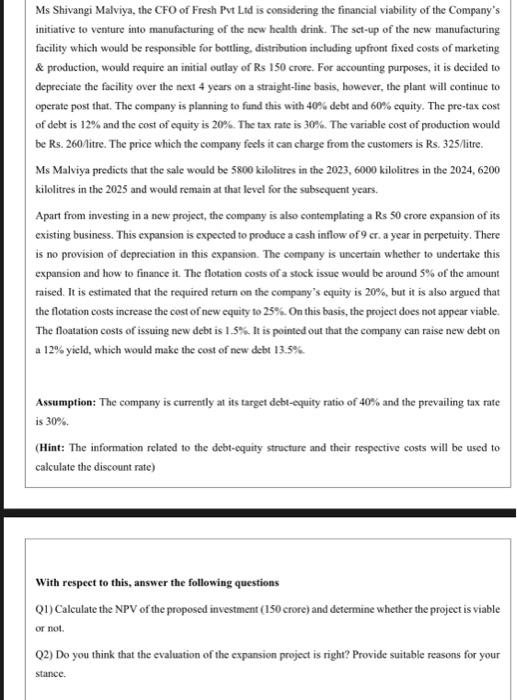Answered step by step
Verified Expert Solution
Question
1 Approved Answer
please answer part 1 Ms Shivang Malviya, the CFO of Fresh P'vt Ltd is considenng the financial vabolity of the Company's initiative to venture into
please answer part 1 
Ms Shivang Malviya, the CFO of Fresh P'vt Ltd is considenng the financial vabolity of the Company's initiative to venture into manufacturing of the ncw health drink. The set-up of the new manufacturing facility which would be responsible for bottling, distribution including upfront fixed costs of marketing \& production, would require an initial outlay of Rs 150 crore. For accounting purposes, it is decided to depreciate the facility over the next 4 years on a straight-line basis, however, the plant will continue to operate post that. The company is planning to fund this with 40 debt and 60 cquity. The pre-tax cost of debt is 12% and the cost of equity is 20%. The tax rate is 30%. The variable cost of production would be Rs. 260 Aitre. The price which the company feels it can charge from the customers is Rs. 325/ litre. Ms Malviya predicts that the sale would be 5800 kilolitres in the 2023, 6000 kilolitres in the 2024, 6200 kilolitres in the 2025 and would remain at that level for the subsequent years. Apart from investing in a new project, the company is also contemplating a Rs 50 crore expansion of its existing business. This expansion is expected to produce a cash inflow of 9cr. a year in perpetuity. There is no provision of depreciation in this expansion. The company is uncertain whether to undertake this expansion and how to finance it. The flotation costs of a stock issue would be around 5% of the amount raised. It is estimated that the required return on the company's equity is 20%, but it is also argued that the flotation costs increase the cost of new equity to 25%. On this basis, the project does not appear viable. The floatation costs of issuing new debt is 1.5%. It is pointed out that the company can raise new debt on a 12% yicld, which would make the cost of new debt 13.5%. Assumption: The company is currently at its target debt-equity ratio of 40% and the prevailing tax rate is 30%. (Hint: The information related to the debt-equity structure and their respective costs will be used to calculate the discount rate) With respect to this, answer the following questions Q1) Calculate the NPV of the proposed investment (150 crore) and determine whether the project is viable or not. Q2) Do you think that the evaluation of the expansion project is right? Provide suitable reasons for your stance. Ms Shivang Malviya, the CFO of Fresh P'vt Ltd is considenng the financial vabolity of the Company's initiative to venture into manufacturing of the ncw health drink. The set-up of the new manufacturing facility which would be responsible for bottling, distribution including upfront fixed costs of marketing \& production, would require an initial outlay of Rs 150 crore. For accounting purposes, it is decided to depreciate the facility over the next 4 years on a straight-line basis, however, the plant will continue to operate post that. The company is planning to fund this with 40 debt and 60 cquity. The pre-tax cost of debt is 12% and the cost of equity is 20%. The tax rate is 30%. The variable cost of production would be Rs. 260 Aitre. The price which the company feels it can charge from the customers is Rs. 325/ litre. Ms Malviya predicts that the sale would be 5800 kilolitres in the 2023, 6000 kilolitres in the 2024, 6200 kilolitres in the 2025 and would remain at that level for the subsequent years. Apart from investing in a new project, the company is also contemplating a Rs 50 crore expansion of its existing business. This expansion is expected to produce a cash inflow of 9cr. a year in perpetuity. There is no provision of depreciation in this expansion. The company is uncertain whether to undertake this expansion and how to finance it. The flotation costs of a stock issue would be around 5% of the amount raised. It is estimated that the required return on the company's equity is 20%, but it is also argued that the flotation costs increase the cost of new equity to 25%. On this basis, the project does not appear viable. The floatation costs of issuing new debt is 1.5%. It is pointed out that the company can raise new debt on a 12% yicld, which would make the cost of new debt 13.5%. Assumption: The company is currently at its target debt-equity ratio of 40% and the prevailing tax rate is 30%. (Hint: The information related to the debt-equity structure and their respective costs will be used to calculate the discount rate) With respect to this, answer the following questions Q1) Calculate the NPV of the proposed investment (150 crore) and determine whether the project is viable or not. Q2) Do you think that the evaluation of the expansion project is right? Provide suitable reasons for your stance 
Step by Step Solution
There are 3 Steps involved in it
Step: 1

Get Instant Access to Expert-Tailored Solutions
See step-by-step solutions with expert insights and AI powered tools for academic success
Step: 2

Step: 3

Ace Your Homework with AI
Get the answers you need in no time with our AI-driven, step-by-step assistance
Get Started


